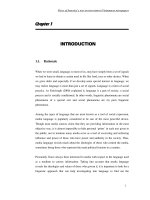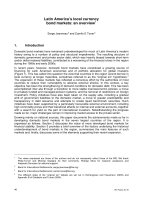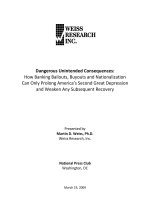why america’s top pundits are wrong anthropologists talk back
Bạn đang xem bản rút gọn của tài liệu. Xem và tải ngay bản đầy đủ của tài liệu tại đây (3.12 MB, 293 trang )
Why America’s Top
Pundits Are Wrong
UC_Besteman (O).qxd 9/3/2004 3:53 PM Page i
California Series in Public Anthropology
The California Series in Public Anthropology emphasizes the anthropologist’s
role as an engaged intellectual. It continues anthropology’s commitment to being
an ethnographic witness, to describing, in human terms, how life is lived beyond
the borders of many readers’ experiences. But it also adds a commitment, through
ethnography, to reframing the terms of public debate—transforming received,
accepted understandings of social issues with new insights, new framings.
Series Editor: Robert Borofsky (Hawaii Pacific University)
Contributing Editors: Philippe Bourgois (UC San Francisco), Paul Farmer
(Partners in Health), Rayna Rapp (New York University), and Nancy
Scheper-Hughes (UC Berkeley)
University of California Press Editor: Naomi Schneider
1. Twice Dead: Organ Transplants and the Reinvention of Death,
by Margaret Lock
2. Birthing the Nation: Strategies of Palestinian Women in Israel, by Rhoda Ann
Kanaaneh (with a foreword by Hanan Ashrawi)
3. Annihilating Difference: The Anthropology of Genocide, edited by Alexander
Laban Hinton (with a foreword by Kenneth Roth)
4. Pathologies of Power: Health, Human Rights, and the New War on the Poor,
by Paul Farmer (with a foreword by Amartya Sen)
5. Buddha Is Hiding: Refugees, Citizenship, the New America, by Aihwa Ong
6. Chechnya: Life in a War-Torn Society, by Valery Tishkov (with a foreword
by Mikhail S. Gorbachev)
7. Total Confinement: Madness and Reason in the Maximum Security Prison,
by Lorna A. Rhodes
8. Paradise in Ashes: A Guatemalan Journey of Courage, Terror, and Hope,
by Beatriz Manz (with a foreword by Aryeh Neier)
9. Laughter Out of Place: Race, Class, Violence, and Sexuality in a Rio Shantytown,
by Donna M. Goldstein
10. Shadows of War: Violence, Power, and International Profiteering in the Twenty-
First Century, by Carolyn Nordstrom
11. Why Did They Kill? Cambodia in the Shadow of Genocide, by Alexander
Laban Hinton
12. Yanomami: The Fierce Controversy and What We Might Learn from It,
by Robert Borofsky
13. Why America’s Top Pundits Are Wrong: Anthropologists Talk Back,
edited by Catherine Besteman and Hugh Gusterson
UC_Besteman (O).qxd 9/3/2004 3:53 PM Page ii
Why America’s Top
Pundits Are Wrong
anthropologists talk back
edited by
catherine besteman and
hugh gusterson
UNIVERSITY OF CALIFORNIA PRESS
Berkeley Los Angeles London
UC_Besteman (O).qxd 9/3/2004 3:53 PM Page iii
University of California Press
Berkeley and Los Angeles, California
University of California Press, Ltd.
London, England
© 2005 by the Regents of the University of California
Library of Congress Cataloging-in-Publication Data
Why America’s top pundits are wrong : anthropologists talk back /
edited by Catherine Besteman and Hugh Gusterson.
p. cm.—(California series in public anthropology ; 13)
Includes bibliographical references and index.
ISBN 0–520-24355-2 (alk. paper).—ISBN 0–520-24356-0 (pbk. : alk.
paper)
1. Mass media and anthropology. 2. Communication and society.
3. Communication in anthropology. 4. Communication—Political
aspects. 5. Specialists. 4. Errors, Popular. I. Besteman, Catherine
Lowe. II. Gusterson, Hugh. III. Series.
p96.a56w49 2005
302.23—dc22 2004014201
Manufactured in the United States of America
13 12 11 10 09 08 07 06 05
1110987654321
The paper used in this publication is both acid-free and totally chlorine-
free (TCF). It meets the minimum requirements of ANSI/NISO Z39.48–
1992 (R 1997) (Permanence of Paper).
UC_Besteman (O).qxd 9/3/2004 3:53 PM Page iv
To Franz Boas and Margaret Mead,
pioneers of public anthropology
UC_Besteman (O).qxd 9/3/2004 3:53 PM Page v
UC_Besteman (O).qxd 9/3/2004 3:53 PM Page vi
Contents
1. Introduction 1
Hugh Gusterson and Catherine Besteman
2. The Seven Deadly Sins of Samuel Huntington 24
Hugh Gusterson
3. Samuel Huntington, Meet the Nuer:
Kinship, Local Knowledge, and the Clash
of Civilizations 43
Keith Brown
4. Haunted by the Imaginations of the Past:
Robert Kaplan’s Balkan Ghosts 60
Tone Bringa
UC_Besteman (O).qxd 9/3/2004 3:53 PM Page vii
5. Why I Disagree with Robert Kaplan 83
Catherine Besteman
6. Globalization and Thomas Friedman 102
Angelique Haugerud
7. On The Lexus and the Olive Tree, by Thomas L.
Friedman 121
Ellen Hertz and Laura Nader
8. Extrastate Globalization of the Illicit 138
Carolyn Nordstrom
9. Class Politics and Scavenger Anthropology in
Dinesh D’Souza’s Virtue of Prosperity 154
Kath Weston
10. Sex on the Brain: A Natural History of Rape
and the Dubious Doctrines of Evolutionary
Psychology 180
Stefan Helmreich and Heather Paxson
11. Anthropology and The Bell Curve 206
Jonathan Marks
Notes 229
Suggested Further Reading 261
List of Contributors 267
Acknowledgments 271
Index 273
UC_Besteman (O).qxd 9/3/2004 3:53 PM Page viii
ONE Introduction
Hugh Gusterson and Catherine Besteman
1
This book confronts some of the most controversial and divisive issues of
the day. Why does poverty persist in the United States? Do the poor,
through laziness or lack of initiative, somehow deserve their plight?
Why do African Americans continue to get left behind in the American
race for success? Are feminists right about violence against women in our
society? How much of our behavior is genetically programmed? Why do
some countries do better than others in the global economy? Why has the
U.S. military found itself fighting Muslims so much of late? Will global-
ization and U.S. intervention abroad create a more peaceful or a more
polarized world? Should the United States have intervened in the former
Yugoslavia in the 1990s, or is that part of the world doomed to bloody
and irremediable ancient hatreds?
In Congress, in coffee shops, in classrooms, in dorm rooms, on talk
UC_Besteman (O).qxd 9/3/2004 3:53 PM Page 1
shows, and over the dinner table, these have been some of the most
debated questions in American public life in recent years. Some of these
questions—about race, gender, and class—are hardy perennials of
American disputation; others, such as those about globalization and the
apparent conflict with Islam, are particular to our times. In our national
debate about such questions, some of the loudest voices belong to pun-
dits: men (and, yes, they do almost all seem to be men) such as Thomas
Friedman of the New York Times, Robert Kaplan of the Atlantic Monthly,
Samuel Huntington of Harvard University, and Dinesh D’Souza of
Stanford University’s Hoover Institute. Some of these pundits are based
in universities, others are not, but they share an ability to reduce contro-
versial issues to sound bites and, consequently, to harness the full power
of the media to project their opinions. Some are self-identified liberals,
while others are conservatives; some focus their attention on international
relations, while others write about domestic politics within the United
States. Although they do not all come from the same side of the political
map, they draw on and embellish a loosely coherent set of myths about
human nature and culture that have a strange staying power in American
public discourse: that conflict between people of different cultures, races,
or genders is inevitable; that biology is destiny; that culture is immutable;
that terrible poverty, inequality, and suffering are natural; and that people
in other societies who do not want to live just like Americans are afraid of
“modernity.” We have put together a book subjecting these pundits to
cold, hard scrutiny because of our concern that, while their voices are
often the loudest, they are not necessarily the wisest. Although they may
be glibly persuasive writers with strong points of view, their writing is
also dangerously simplistic and ideologically distorted.
Pundit comes from the old Hindi word pandit, used to refer to a teacher
of Indian religion and law.
1
The Oxford English Dictionary defines a pun-
dit as “an authority on a subject.” Merriam-Webster’s gives two defini-
tions. The first—“a learned man; teacher”—echoes the Oxford English
Dictionary. The second—“one who gives opinions in an authoritative
manner”—is more to the point here. The pundits we discuss here are not
particularly learned and are only superficially authorities on the subjects
about which they write. Their skill lies not in detailed knowledge about
2 Hugh Gusterson and Catherine Besteman
UC_Besteman (O).qxd 9/3/2004 3:53 PM Page 2
their subject but in their ability, in an age of mass media and short atten-
tion spans, to learn quickly about the broad contours of a wide range of
subjects and to project confidence and authority in talking about them.
Indeed, their skill often lies not in authoritative knowledge of their sub-
ject but in their ability to hide their lack of authoritative knowledge.
Pundits are people who, like the New York Times columnist Thomas
Friedman, speak to a general audience rather than to specialists, often on
many different issues. To win and keep a wide audience, they have to
hurl out bold ideas, make big generalizations, and speak colorfully.
While they are expected to pepper their arguments with facts and infor-
mation, they know that their audiences will not—and usually cannot—
judge them on their detailed knowledge of the subject at hand and will,
instead, judge them on their ability to appear knowledgeable and be
entertaining. This means that the pundits who thrive the most are those
who cater to their audiences’ existing prejudices, rather than those who
upend their easy assumptions about the world and challenge them to see
the world from a new angle. As the cultural critic Edward Said puts it, in
reference to the appeal of Samuel Huntington’s Clash of Civilizations, one
of the works we discuss in this book, “What has made it strike so respon-
sive a chord among post–cold war policy makers, is this sense of cutting
through large amounts of unnecessary detail, of masses of scholarship
and huge amounts of experience, and boiling all of them down to a cou-
ple of catchy, easy-to-quote-and-remember ideas, which are then passed
off as pragmatic, practical, sensible, and clear.”
2
Pundits, then, are modern-day mythmakers. All societies have myth-
makers—people who provide a comforting explanation of why things
are the way they are. Mythmakers provide a way to make sense of com-
plexity, to reconcile contradictory realities, and to justify a particular
course of action or worldview. They help a society imagine itself and its
role in the world. Mythmakers in “primitive” societies explained why
children died, why crops failed, and why chiefs were chiefs and the rest
were not. They found design and purpose in pain and suffering.
Mythmakers in contemporary America provide just-so stories to explain,
for example, why many foreigners are angry at the United States, why
the poor are poor, and why racial inequality persists.
Introduction 3
UC_Besteman (O).qxd 9/3/2004 3:53 PM Page 3
The pundits we review here are American mythmakers with author-
ity.
3
They have captured our attention because of their book sales, their
high profiles in public discourse, and their ability to influence the high-
est policy makers in the land. They are not the most extreme of America’s
contemporary commentators—the Ann Coulters and Bill O’Reillys.
Rather, they hold positions at famous universities, publish in mainstream
news magazines and newspapers, and are read by American presidents.
While they successfully present themselves as globally knowledgeable
and reasonable commentators, the myths they promote exert a reac-
tionary force in public life. Often based on stereotypes of other people,
these myths hobble our ability to think critically or to empathize with dif-
ferent kinds of people, and they have the effect of legitimating the status
quo. They are also based on wrongheaded assumptions about human
nature that we are determined to debunk.
All the contributors to this volume are distinguished and experi-
enced anthropologists who can no longer watch America’s pundits at
work without speaking up. As anthropologists, we specialize in study-
ing human nature, cultural interaction, ethnic conflict, social stratifica-
tion, and the workings of race and gender—all the issues the pundits
write about. In the following chapters we demonstrate over and over
that the myths of the punditocracy, whether overtly liberal or conserva-
tive, are based on loudly voiced rhetorical and not scientific claims,
and on the cultural assumptions of the privileged. Uncorrected, their
assumptions about human nature and culture are not just wrong but
also, given the pundits’ influence in American public life, dangerous.
Although most of the contributors to this book are to the left of political
center, we do not have a shared political agenda. We are less concerned
with speaking as exponents of a particular political philosophy than as
anthropologists. We see America’s pundits, in turn, not as sectarian
partisans but as joint contributors to a set of “myths we live by.” Anthro-
pology’s traditional charge is to understand myths as charters for world-
views and ways of life. We evaluate myths that societies tell about them-
selves and others, and we try to understand where these stories came
from, why they endure, and most important for our purposes here, how
they might be dangerous. After all, some myths justify unnecessary
4 Hugh Gusterson and Catherine Besteman
UC_Besteman (O).qxd 9/3/2004 3:53 PM Page 4
human suffering while breeding fear, xenophobia, and ignorance about
other ways of life.
As anthropologists who have all done fieldwork, we get our knowl-
edge by deeply engaged, intense, face-to-face research, often in settings
where disease and violence pose a real threat. Along with reading all the
learned books and professional journals related to our subjects, we spend
years in local communities, listening, observing, interviewing. Wanting
all sides of the story, we talk with everyone from government officials
and executives to peasants, activists, workers, and criminals. We are
experts in the history, the politics, and the economics of the places we
study, but we also understand these places in terms of the human inter-
actions we have had with the people who live there. Significantly, our
methodology encourages in-depth relationships with people generally
ignored by pundits—those on the margins of society, rather than just the
elite. Anthropology has a historical commitment to take seriously the
perspectives of non-Western societies and non-elites. Such perspectives
are front and center in our analyses, and they undergird anthropology’s
distinctive view of the world. Ours is the discipline whose best-sellers
include the biography of a !Kung bushwoman in South Africa and the
story of Ishi, “the last of his tribe” of Native Americans.
4
Now, in the era
of globalization and cyberspace, we are reporting on conversations with
war refugees in the Congo, Islamic militants in the slums of Egypt, illegal
immigrants who clean your local Wal-Mart and can barely make the rent,
and young women who lose their eyesight assembling computers in
sweatshops in Malaysia and the Philippines. We bring into the global
conversation the voices that would otherwise be lost. Good anthropol-
ogy, like good literature, challenges readers to see the world from inside
someone else’s skin and to rethink taken-for-granted assumptions.
The arguments we challenge here were published in articles and books
that received widespread media attention in the 1990s, but our decision
to write this book took on particular force with the renewed power and
prominence of these writings following the September 11, 2001, tragedy
and the American invasion of Iraq. The need to define the contours of the
post–cold war world has taken on a new urgency for Americans reeling
from the shock of a devastating terrorist attack on American soil and
Introduction 5
UC_Besteman (O).qxd 9/3/2004 3:53 PM Page 5
6 Hugh Gusterson and Catherine Besteman
mired in the chaos of a post-Saddam Iraq. When we discovered that
books by some of the pundits we target—Robert Kaplan, Samuel
Huntington, and Thomas Friedman—were being promoted by a major
national bookstore chain as useful roadmaps to our global reality in the
era of the war on terrorism, we realized that our task—to draw on our
anthropological knowledge to tell more accurate stories about the post–
cold war world—was more important than ever. There was a time before
the Vietnam War when anthropologists were themselves pundits playing
a vital role in public debate. Franz Boas, the founder of modern American
anthropology, championed Native Americans and was an outspoken
public critic of eugenics and of racially biased intelligence testing in the
early twentieth century. Margaret Mead, the most famous anthropologist
of the twentieth century, used knowledge she gained from her research
on adolescence and gender among Pacific Islanders to intervene in pub-
lic debates about American sex roles and education. With less happy con-
sequences, Margaret Mead also intervened in public policy debates about
American foreign policy, including the Vietnam War. The debates of the
Vietnam era, which left the American Anthropological Association
deeply divided over the ethics of military research and over the propri-
ety of the Vietnam War itself, scarred anthropology and left many anthro-
pologists feeling that it was safer to avoid participation in national policy
debates. We came together to write this book out of the conviction that it
is time for anthropologists to reclaim Margaret Mead’s legacy and find
our voice as public intellectuals once more.
The Pundits Look Abroad
Let’s begin with Robert Kaplan. Described by the New York Times as com-
bining “the attributes of the journalist and the visionary,”
5
he is the
author of the influential books Balkan Ghosts and The Coming Anarchy.
Balkan Ghosts was published in 1993 just as the former Yugoslavia was
beginning to come apart at the seams and the newly elected U.S. presi-
dent, Bill Clinton, was deciding whether or not to reverse the policy,
inherited from his predecessor, of nonintervention in the Bosnian conflict.
In Balkan Ghosts Kaplan sketched a picture of the Balkans as a region
UC_Besteman (O).qxd 9/3/2004 3:53 PM Page 6
Introduction 7
doomed to perpetual strife because of ancient feuds and grievances dat-
ing back to the Middle Ages that set Orthodox, Catholic, and Muslim cit-
izens at each others’ throats. Although Kaplan was not an expert in
Balkan history or culture, the commonsense appeal of his “ancient
hatreds” argument combined with a muscular and vivid writing style
won his book a wide audience at a time when newspaper and television
screens were full of searing images of atrocities from the Bosnian war. Bill
Clinton read the book during his first term as president, and it is said that
Kaplan helped persuade him for a long time that people in this corner of
the world had always hated one another and probably always would,
and that the United States should stay out of their conflicts. Balkan Ghosts
is a discomfiting reminder of the terrible damage that can be done by an
author with a persuasive writing style and a good publicist, even if the
account is largely a mishmash of myth, superficial impressions, and recy-
cled stereotypes.
In the present volume, Tone Bringa sets the record straight on Bosnia.
Unlike Kaplan, Bringa did not simply pass through the Balkans between
book tours. Bringa is an anthropologist who won her knowledge the hard
way—by living in a Bosnian village before and during the Yugoslav wars
of the 1990s, getting to know its Bosnian Muslim and Croat Catholic
inhabitants intimately. She was there when the villagers turned on one
another. While Kaplan would have us believe that people in this part of
the world were just itching for a chance to revisit old grievances, Bringa
points out that, until the ethnic cleansing of the 1990s, Muslim and
Catholic villagers had strong neighborly friendships. These interethnic
friendships had been the rule rather than the exception in this part of the
world and were blown apart only under the pressure of a war begun by
Serb separatists in Belgrade. Far from being eager to attack one another,
villagers finally turned against one another only after hard work by
nationalist politicians. Bringa suggests that Kaplan’s question—can these
people ever be expected to get over their differences?—is the wrong
question to ask. The right question, and the question Bringa addresses, is,
How were people who had lived quietly together as neighbors for forty-
five years manipulated into killing one another and burning each other’s
houses down?
Kaplan’s subsequent book, The Coming Anarchy, was no less influential
UC_Besteman (O).qxd 9/3/2004 3:53 PM Page 7
and, unfortunately, no less misguided. The book was preceded by an
Atlantic Monthly article of the same name that was, remarkably, faxed by
the U.S. State Department to every U.S. embassy in Africa. In it, Kaplan
argues that the world is increasingly divided between the orderly, afflu-
ent societies of the West and anarchic, crime-ridden, overpopulated Third
World societies headed for environmental degradation, outbreaks of dis-
ease, downward spirals of poverty, and civil strife. He likens the citizens
of the West to passengers in a stretch limo, saying, “Outside the stretch
limo would be a rundown, crowded planet of skinhead Cossacks and
juju warriors, influenced by the worst refuse of Western pop culture and
ancient tribal hatreds, and battling over scraps of overused earth.”
6
Warning about “places where the Enlightenment has not penetrated,”
and predicting that “distinctions between war and crime will break
down,”
7
he fears that globalization will make it harder and harder for the
people in the stretch limo to avoid “the coming anarchy.” Telling us that
democracy is culturally unnatural in many parts of the globe, and that
some cultures are too weak or pathological to cope with the stresses of
globalization, he predicts that anarchic waves of crime and violence will
wash across various regions of the globe, particularly Africa.
In chapter 5 below, Catherine Besteman takes issue with this dystopic
vision of the present and the future. An anthropologist who has worked
in Africa for many years, particularly in Somalia and South Africa,
Besteman points out that the impression Kaplan gives of the African con-
tinent as an imploding zone of chaos and crime is empirically selective—
that while Africans may be poor, in many parts of the continent their soci-
eties are peaceful and orderly. Echoing Bringa on the Balkans, she exco-
riates Kaplan for his attribution of “ancient tribal hatreds” to Africans,
pointing out that colonial powers in Africa practiced a form of divide and
rule that created and exacerbated tribal identifications, and that these
“hatreds,” far from being “ancient,” are recent inventions. She also points
out that, while Kaplan gives the impression that Third World societies are
being eaten away by their own internal weaknesses (tribal hatreds, a con-
genital inability to create strong states, and an inability to control popu-
lation), they are actually being undermined and deformed by exploitive
relationships with the West. Western nations have made them a source of
8 Hugh Gusterson and Catherine Besteman
UC_Besteman (O).qxd 9/3/2004 3:53 PM Page 8
cheap raw materials and underpaid labor, and agencies such as the
International Monetary Fund (IMF) have forced them to cut social pro-
grams in order to demonstrate fiscal discipline. It is not that their unique
cultural weaknesses are creating a wave of anarchy that may spread like
a tidal wave from the Third World and drown us all, but that our rela-
tionships with them are generating suffering and exploitation that may
blow back on us in the West.
The deformities in Kaplan’s writing are, sadly, not unique to him.
They form part of a broader pattern of distorted vision on the part of con-
temporary commentators that lends a coherence to the work of the pun-
dits discussed in this book—even though they address quite disparate
topics and would not see themselves as a unified group. Look at some of
Kaplan’s major themes—the inertia of ancient cultures and conflicts, the
alleged inability of much of the Third World to deal with modernity, and
the innocence of elites in the suffering of others—and you will find ideas
that recur in different forms in the work of all the pundits we discuss in
this book, like viruses that keep mutating and coming back. Thus, for
example, if Kaplan presents human beings as captives of timeless, frozen
cultural imperatives, a similar assumption mars Thomas Friedman’s
writing on “olive tree” cultures that cannot deal with modernity, Samuel
Huntington’s work on a supposedly predetermined “clash of civiliza-
tions,” and Thornhill and Palmer’s argument that contemporary men are
compelled by ancient evolutionary imperatives to behave like sexual
cavemen. In Kaplan’s writing about the Balkans and about a rising tide of
violence in the Third World, we see a penchant for blaming the victims.
Similarly, Dinesh D’Souza blames poverty on the indolence and incapac-
ity of the poor, Herrnstein and Murray say that intellectual inadequacy
has held back African Americans, and Thornhill and Palmer tell us that
women who do not want to be raped should not wear short skirts.
These are more than superficial resemblances. The pundits discussed
here were all writing at a moment in time—on the brow of the new mil-
lennium—when the social and intellectual order of the late twentieth
century, both at home and abroad, was suddenly up for grabs following
the end of the cold war. This was a moment characterized in the interna-
tional system by an intensification of globalization and civil conflict and,
Introduction 9
UC_Besteman (O).qxd 9/3/2004 3:53 PM Page 9
within the United States, by fierce debate about the domestic legacies of
the 1960s, especially the civil rights and women’s movements. At a
moment when progressives, responding to the end of the cold war and
the election of a democratic president and Congress, hoped that the
1990s would see a substantial demilitarization of global society, greater
equality within and between societies, and further progress in civil and
human rights, the pundits discussed in this book argued against them on
many fronts. They argued that the world after the cold war was destined
to be a violent one full of new threats to the West; they attacked the
naïveté of those who argued for democratic forms of globalization that
would ameliorate social conflict and inequality; and they disputed
insights from the 1960s that the plight of women, the poor, and people of
color was the product of an entire social system—a system that could be
changed. Taken together, in other words, the pundits we discuss here
have been engaged in a collective assault on the legacies of the Great
Society era in American history. In the works discussed here, they are
attempting to replace an established recognition—that we are all con-
nected and that it is within our power to collectively change and improve
our world—with a sort of neo-Darwinist ideology reminiscent of the
ugly and mean-spirited ideas ascendant in the period of high capitalism
and colonialism at the turn of the nineteenth century. The new social
Darwinists preach the inescapability of conflict and competition, the
unreformability of those who are not like “us,” and the responsibility of
the poor, the weak, and the oppressed for their own suffering. In writ-
ings on international affairs, expressions of this ideology range from
Friedman’s strident neoliberalism to Huntington’s smug cultural sepa-
ratism; in discussions of domestic politics, we see a revivification of old
Dickensian ideas that everyone gets what they deserve.
These arguments offend us not only because of the callous politics that
underlie them but also because they are sustained through a willful igno-
rance of a huge swathe of human experience and academic knowledge
that we, as professional anthropologists, claim as our professional
domain. For example D’Souza’s arguments about the poor, Herrnstein
and Murray’s arguments about the low intelligence of African Ameri-
cans, and Thornhill and Palmer’s arguments about an alleged male
10 Hugh Gusterson and Catherine Besteman
UC_Besteman (O).qxd 9/3/2004 3:53 PM Page 10
propensity for rape fly in the face of decades of painstaking research by
social scientists. Similarly, the assumptions about frozen traditions, con-
flicts, and cultures that one finds in the work of Friedman, Kaplan, and
Huntington are premised on a stunning ignorance of the professional lit-
erature on culture and tradition—a literature that emphasizes the fluid-
ity and malleability of culture and argues that ethnic conflict in such
places as Rwanda and Bosnia has been the product of recent pressures,
not ancient hatreds. The anthropologists in this book critique these ideas
and the pundits who propound them in the fresh, vigorous prose of the
punditocracy itself, but they do this without compromising their learning
or simplifying the issues at stake.
Samuel Huntington, another pundit who writes on international affairs,
is a Harvard professor who first became notorious as one of the architects
of the “strategic hamlet” policy of counterinsurgency in the Vietnam War.
In the 1990s, setting his jaw against Clintonist internationalism, he
moved into the public eye once more with his predictions of an impend-
ing “clash of civilizations,” which made him a cause célèbre, especially
among those who hoped that the end of the cold war would not mean the
end of cold-war levels of military spending. According to Huntington,
the world contains seven civilizations: Western, orthodox, Chinese,
Japanese, Hindu, Islamic, and Latin American. (If you are wondering
where Africa went, Huntington is not sure that it qualifies as a civiliza-
tion). Of these civilizations, Huntington sees the West as uniquely com-
patible with democracy, human rights, and secular reason. He has a spe-
cial animus against Islam, which he presents as incompatible with
modernity, saying that “Muslim bellicosity and violence are late twenti-
eth century facts” and that “Muslims have problems living peacefully
with their neighbors.”
8
Claiming that wars tend to occur on the “fault
lines” between civilizations rather than within them, Huntington argues
that globalization will probably intensify global conflict. This is because
globalization makes it harder for countries to stay within their own civi-
lizational backyards and because globalization is creating multicultural
societies that, according to Huntington, suffer from “cultural schizo-
phrenia” and are therefore unsustainable. He says, for example, in an
Introduction 11
UC_Besteman (O).qxd 9/3/2004 3:53 PM Page 11
argument that echoes Kaplan’s warnings about the perils of multicultur-
alism, that the influx of Mexican immigrants into the United States cre-
ates a sort of Latin American fifth column within the United States that
may eventually cause the loss of territory the United States once took
from Mexico.
Hugh Gusterson, an anthropologist who writes on international secu-
rity issues, attacks Huntington for the incoherence of his basic categories
and for his cartoonish caricatures of complex cultural traditions. He
points out, for example, that Huntington’s separation of “Western” and
“Orthodox” civilizations (the latter including both Russia and Greece) is
odd, since so many cultural conservatives in the United States trace
Western civilization and its democratic traditions back to the ancient
Greeks. Gusterson also suggests that Huntington’s characterizations of
different cultures are often based on egregious stereotypes (Muslims are
violent fundamentalists, the Chinese are authoritarian) that blur the
diversity of opinion and belief within a society and deny the ability of
societies to change over time. Taking issue with Huntington’s represen-
tation of civilizations as enacting a timeless essence, Gusterson argues
that if Europe “could evolve from a period when there was no schism
between Protestantism and Catholicism, and an assumption that kings
ruled by divine right, to today’s secular and pluralistic democracies,”
then surely the other civilizations of the world can also change in sub-
stantial and unpredictable ways.
Keith Brown’s critique of Huntington is based on a fascinating close
reading of his use of the notion of “kinship” within civilizations as a force
in international relations. Kinship has traditionally been one of the cen-
tral topics in anthropology, which has documented an astonishing vari-
ety of kinship practices around the world. By shining a light into the gap
between Huntington’s simplistic assumptions about kinship and anthro-
pologists’ rich knowledge of kinship as it is actually lived in all its diver-
sity, Brown illuminates the simplifications and false assumptions that
mar Huntington’s work more generally. Huntington’s argument depends
upon a crude determinism that assumes civilizational “kin” will always
tend to take one another’s side against outsiders—like the Orthodox
Russians tilting toward the Serbs in Yugoslavia in the 1990s. Brown
12 Hugh Gusterson and Catherine Besteman
UC_Besteman (O).qxd 9/3/2004 3:53 PM Page 12
points out that, in the Balkans, this generalization seems highly dubious
once one takes more than a superficial look. Thus, for example, the pre-
dominantly Christian United States was willing to take military action on
behalf of the Bosnian Muslims and Muslim Kosovars in the 1990s, and,
on the ground, other alliances in the region turned out to be more com-
plex and counterintuitive than a theory of civilizational affinity would
predict. Brown points out that marital ties can be as important as blood
ties, and that, in the Balkans as in many other parts of the world, there are
relations of “fictive kinship”—as exemplified by godparents—that
enable people to turn allies and friends unrelated by blood into kin.
Using as his starting point a Kosovar who named his daughter Kfor (after
NATO forces) and who wanted a NATO general to be her godfather,
Brown argues that new nations and oppressed peoples in eastern Europe
in the 1990s used the idioms of fictive kinship to make real a powerful
sense of lived solidarity with the United States, and that, more broadly,
Huntington’s flat and impoverished use of kinship as a way of under-
standing international alliances rests on a grave misunderstanding of the
pliability of actual kinship relations and an underestimation of the
human capacity to imagine relations of solidarity with others.
Our third foreign affairs pundit, Thomas Friedman, chides Kaplan and
Huntington for their negativity and suggests that globalization and inter-
national trade can counteract tendencies toward anarchy or civilizational
clashes. Best known for his biweekly opinion column in the New York
Times and an earlier book on the politics of the Middle East, Friedman is
also the author of The Lexus and the Olive Tree, a book that is, by nonfiction
standards, a best-seller. Five years after its initial publication, it is still
among the few hundred top sellers on Amazon.com. The Lexus in
Friedman’s title, a luxury automobile, represents the promise of affluence
in globalization; the olive tree, the pull of the traditions that often inhibit
countries from embracing market capitalism and its promise of progress
and modernity. Friedman writes that a world without barriers to the flow
of goods, ideas, and capital—a globalized system based on neoliberal
economic policies—is the best hope for economic growth, political
progress, and a world at peace. (Friedman claims that no two countries
with McDonald’s franchises have ever gone to war with one another.)
Introduction 13
UC_Besteman (O).qxd 9/3/2004 3:53 PM Page 13
Countries that refuse to embrace globalization, according to Friedman, are
often inhibited by a fear of modernity and an irrational attachment to cul-
tural tradition. Such countries will be left behind economically. The only
hope for them is to open themselves to the market rationality of the “elec-
tronic herd” of banking experts and investors and to “globalution”—
democratic revolution through globalization; the big danger is that they
will allow themselves to be led astray by the “backlashers” and ignorant
“turtles” who “just don’t have the skills sets or the energy to make it into
the Fast World.”
9
In this book, chapters by Angelique Haugerud, by Carolyn Nordstrom,
and by Ellen Hertz and Laura Nader reveal the shallowness of Friedman’s
arguments. Angelique Haugerud, an anthropologist who spent fieldwork
time in Africa over a period of two decades, and who is currently study-
ing globalization activists, suggests that Friedman “misses the main
story” about globalization. She argues that Friedman is so blinded by his
perception of a global clash between modernity and tradition, and that his
knowledge of the countries he jets into is so superficial, he cannot see that
what he calls tradition is far from traditional. Friedman, Haugerud tells
us, perceives a “dichotomy between two rigidly separate worlds: that
of the constantly ringing cell phones in his train car full of forward-look-
ing middle- and upper-class Egyptians, and that of the ‘barefoot Egyptian
villagers tilling their fields with the same tools and water buffalo that
their ancestors used in Pharoah’s day.’” This latter image, Haugerud
notes, is visually arresting, but it is also “utterly false,” given “Egypt’s
long history of agricultural innovation.” Moreover, Haugerud points out,
these villages with their water buffalo are actually at the center of a glob-
alization from below, which Friedman fails to see. Many villagers have left
the village to try their luck as migrant laborers in Egypt and beyond, and
their relatives depend on the money they send and on the knowledge of
labor and commodity markets they embody.
In the end, Haugerud concludes, Friedman’s dichotomy between
modernity and tradition is a phony distraction from the reality that resis-
tance to globalization is “rejection not of modernity per se, but of the
social injustices, environmental destruction, and brutal economic in-
equality that can accompany industrialization and economic neoliberal-
14 Hugh Gusterson and Catherine Besteman
UC_Besteman (O).qxd 9/3/2004 3:53 PM Page 14
ism.” Observing that “globalizers” include migrant workers, protesters
against the World Trade Organization, and rural farmers—rather than
merely the banking and political elite so favored by Friedman—
Haugerud explains that “what villagers, migrants, shantytown dwellers,
and protesters seek is global and local social justice, not isolated olive
groves of tradition.” The globalizers from below who interest Haugerud
are concerned with the neoliberal policies that shape how people must
participate in the current global economy. Thus Haugerud concludes her
chapter by offering ideas for reforming globalization and enhancing its
possibilities. Activists in the West and Third World villagers, whom
Friedman so deprecates, do not insist on living in the past, but instead
ask what alternative forms of globalization we might pursue in the
future. While Friedman presents an up-or-down choice—globalization
or no globalization?—they ask, “Globalization for whom?”
Where Friedman suggests that poor countries will be the coun-
tries unable or unwilling to participate in the global market, Carolyn
Nordstrom, drawing on many years of field research in such desperately
poor countries as Mozambique and Angola, shows that in reality this is
not true. Nordstrom argues that, while poor African countries may
appear to be left out of globalization according to official IMF or World
Bank indices, they actually have huge black-market sectors that bring
everything from weapons to cigarettes into the country while extracting
diamonds (known to the locals as “conflict diamonds”) and other pre-
cious materials for sale on terms highly favorable to the West and highly
exploitive of the bulk of the local population. If Friedman thinks such
countries have been left out of globalization, or that globalization will
produce stable and balanced economic growth for their peoples, it is
because he cannot tell the difference between the UN or IMF statistics he
reads in the limousine from the airport and the world of the people his
limousine whizzes past. (As Hertz and Nader observe, Friedman “has
not talked to very many different kinds of people on his jaunts across the
four-star-hotel-dotted globe.”)
Pointing out that experts estimate that the black market represents 50
percent of Mozambique’s economy and a staggering 90 percent of
Angola’s, Nordstrom warns of the danger of relying on formal economic
Introduction 15
UC_Besteman (O).qxd 9/3/2004 3:53 PM Page 15









